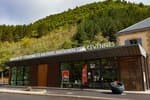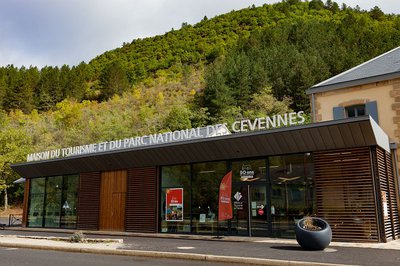
Gralhon
This fairly short trail is ideal for those who are unsure about braving the tough ascent to the Causse plateau. It leads hikers under the cliffs, from where they have towering views over the small town of Florac nestling in the hollow of the narrow Tarnon valley, and then into the very heart of a chestnut grove.
6 points of interest
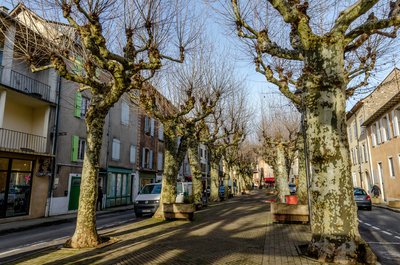
PROHIN Olivier  History
HistoryThe Esplanade
The covered passage of the sub-prefecture is one of several in Florac, running beneath the houses. You have just gone through the former town wall and now find yourself inside the medieval town. Besides the beautiful ancient plane trees (the oldest are 200 years old), you can see, at one end, the statue of Léon Boyer, who built the Garabit viaduct with Gustave Eiffel and died in 1883 in Panama, where he was working on the construction of the Canal; and at the other end, the temple (Protestant church) and the War Memorial.

PROHIN Olivier  History
HistoryThe Planet neighbourhood
In the 16th and17th centuries, a large number of religious conflicts between Catholics and Protestants affected the Cévennes, bringing with them much destruction. After the Peace of Alais was signed by Richelieu and the Duke of Rohan in June 1629, Protestants retained the right to practise their religion, but their fortifications were razed. This included Florac's town walls. The house bearing this information panel is one of the town's oldest: its tower used to watch over Thérond Gate. It also stands at the crossroads of the former road linking Nîmes with Saint-Flour and the former road from Florac to Séverac via the Causse plateau.
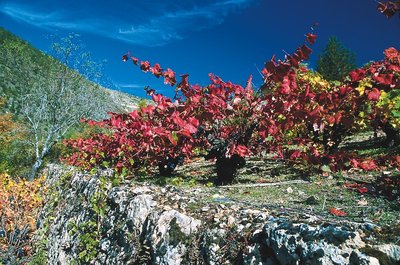
Vigne à Molines - © jean Pierre Malafosse AgricultureThe vines of Florac
Some vines still grow at the edges of paths or cling to trees and scrub; a few people still make their own wine. But today it is an anecdotal activity. Florac was once encircled by grapevines growing on terraces, and every farmer made several hundred litres of wine. But in around 1945, rural flight and the arduousness of the work led to these vine arbours being abandoned. In 2003, two wine-growers moved to Ispagnac, and viticulture was reborn.
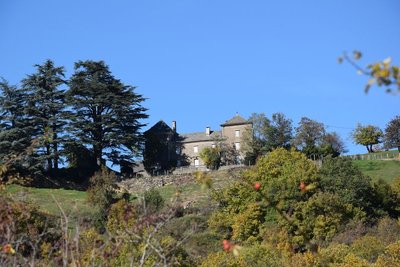
Vue sur le manoir de Gralhon - © com com Florac Sud Lozère  Geology
GeologyGralhon manor
"Gralhon Manor owes its construction here to the presence of a flat area consisting of fairly soft marl – whose gently-sloping profile is well-suited to crop cultivation – and of a spring located just above the houses. The water re-emerges here, having gone through the Causses limestone and hit impermeable schist. Its name might come from the Occitan gral, the raven – the real raven, which nests in the cliffs of the Causse, and not the crow.” (P. Grime)
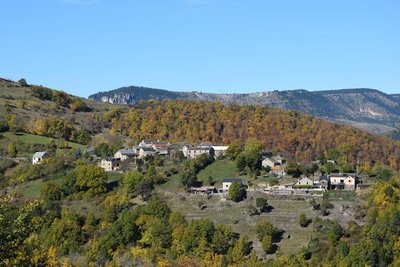
Vue de Monteils depuis Gralhon - © com com Florac Sud Lozère  History
HistoryBrutus Cazal, poet and committed citizen.
Monteils is the hamlet in which Louis Brutus Cazal was born and died. He was one of those primary school teachers who were nicknamed “black ravens of the Republic”. He called his daughters Léa Fraternité and Léa Liberté to express his republican sentiments, which were common to many Protestant families at the time. A poet and defender of the Occitan language, he wrote a collection of poems entitled Les Lozériens. From 1925 on, he devoted himself to tourism in the Cévennes and founded the Club Cévenol. His son, Aimé Cazal, laid out two important tourist sites: Bramabiau chasm and Dargilan cave.

 Geology
GeologyThe iron-rich water of Salce
After a small detour from the hamlet of
Salièges to the river Tarn, you will come across a spring of ferruginous water. For a long time, the ability to prevent (or cure) alcoholism was attributed to this water rich in Fe2+ ions, and made famous by a sketch by the stand-up comedian Bourvil. It supposedly supplies the iron that would normally come from regularly drinking alcohol. A small construction indicates the Salce spring (the path from Salièges is way-marked), as does the red tinting from iron oxide, which you find in many contact zones between schist and limestone.
Description
- At the second crossroads, in a big bend, go straight ahead and immediately take the path on the left going uphill towards a house. There, take the path on the right.
- At Gralhon, follow the road for 400 m.
- Leave the road to take a track on the right that runs along a flat ledge of the Causse Méjean, below the cliffs, to the hamlet of Monteils.
- Go through the hamlet.
- As you leave it, take on your right a path that goes downhill through the chestnut grove, cutting across the road. Cross an old bridge as you come out of the forest, then take the road to Salièges.
- From here, follow the road downhill and along the river Tarn to Florac.
- Departure : Florac: joint tourist office and National Park information centre
- Arrival : Florac: joint tourist office and National Park information centre
- Towns crossed : Florac Trois Rivières
Forecast
Altimetric profile
Recommandations
Make sure your equipment is appropriate for the day's weather conditions. Remember that the weather changes quickly in the mountains. Take enough water, wear good shoes and put on a hat. Please close all gates and barriers after yourself.
Information desks
Tourism'house and national Parc at Florac
Place de l'ancienne gare, N106, 48400 Florac-trois-rivières
This office is part of the National Park's associated tourist-information network, whose mission is to provide information on, and raise awareness of, the sites and events as well as the rules that must be observed in the National Park's central zone.
On site: exhibitions, video projections, events and shop Open year-round
Transport
Bus line 258 “Florac – Sainte-Enimie – Le Rozier”, every day in July and August
Bus line 261 “Florac – Le Pont de Montvert – Mont Lozère”, every day in July and August
Bus line 251 "Florac – Mende”
Year-round daily service Monday to Saturday
Bus line 252 “Ispagnac – Florac – Alès”
https://lio.laregion.fr/
Access and parking
On the RN106, car park in front of the former train station, now the Maison du Tourisme et du Parc national des Cévennes (joint tourism office and National Park information centre).
Parking :
Calculateur d'itinéraire Lio
Utilisez le calculateur liO pour organiser votre trajet en région Occitanie.
Autres régions
Calculez votre itinéraire en Auvergne Rhône Alpes sur Oùra
Biodiversité autour de l'itinéraire
Source
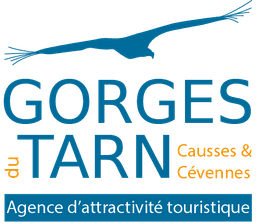

Report a problem or an error
If you have found an error on this page or if you have noticed any problems during your hike, please report them to us here:

